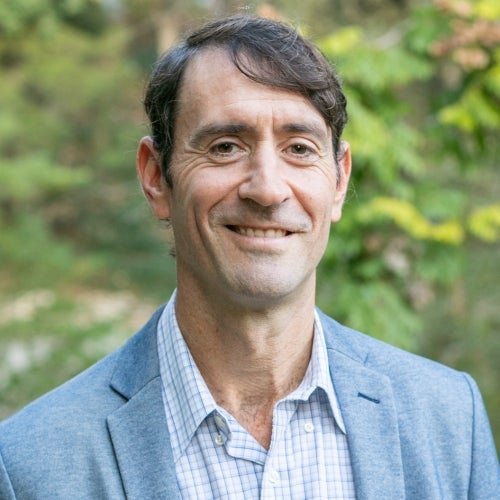Q&A | The Pandemic's Toll on Youth Mental Health
FSPH professor Dr. Daniel Eisenberg discusses concerns about the mental well-being of children, adolescents, and young adults that have been magnified by COVID-19.

“Mental health for children and young adults was already on the rise as a public health issue, and the pandemic has shone a brighter spotlight on that.”
IN DECEMBER 2021, U.S. Surgeon General Dr. Vivek Murthy issued an advisory highlighting the “urgent need to address the nation’s youth mental health crisis,” calling for a swift and coordinated national response in the face of the COVID-19 pandemic’s “unprecedented impacts on the mental health of America’s youth and families, as well as the mental health challenges that existed long before the pandemic.” A poll by the American Psychiatric Association released in May 2021 found that more than half of U.S. parents expressed concerns about their children’s mental well-being.
Dr. Daniel Eisenberg, professor of health policy and management at the UCLA Fielding School of Public Health and director of the mental health program at FSPH’s Center for Health Policy Research, focuses on improving the understanding of how to effectively invest in adolescent and young-adult mental health. Eisenberg is the founder and principal investigator of the Healthy Minds Network for Research on Adolescent and Young Adult Mental Health, which administers the Healthy Minds Study — a national survey of student mental health and related factors — and facilitates the development, testing, and dissemination of innovative programs and interventions for student mental health. Eisenberg spoke with the UCLA Fielding School’s Public Health Magazine on the mental health impact of COVID-19 on the nation’s youth, and the importance of evidence-based solutions.
Q: What do you expect will be the enduring mental health impact from the pandemic on young people?
A: One major concern identified is school-age children having fallen behind in some of the basic math and reading skills — especially younger kids, for whom it was most difficult to engage online. Research also shows that there seems to be a deficit in social skills for younger children.
These academic and social effects on younger children will probably take the longest to recover from.
In terms of direct mental health effects, the research is less clear. Obviously, many families in the United States have experienced significant financial hardship, illness, and death. But data, for example, from our large survey study of college students’ mental health indicates that we have seen the same steady increase in depression and anxiety that we were seeing prior to COVID-19. Mental health for children and young adults was already on the rise as a public health issue, and the pandemic has shone a brighter spotlight on that.
Q: What do we know about the causes of increased mental health problems among young people predating the pandemic?
A: One of the leading explanations, especially for teenagers, has to do with digital media — particularly because the rise seemed to be especially sharp roughly between 2010 and 2020, which coincides with a dramatic increase in the use of digital and social media both among that age group and overall, as smartphones became ubiquitous through much of our society. One underappreciated way in which that trend has been harmful is its effect on the amount and quality of sleep young people are getting. Then there’s the more discussed pathway, which has to do with social comparison — young people seeing what everyone else is doing and defining their own identity in terms of what other people say and do. We know, from lots of psychological research, that’s not healthy.
Of course, even before the pandemic, digital media has had enormous benefits alongside these harms. And during the pandemic, online media helped buffer us against isolation, though it certainly doesn’t replace our in-person lives. So the solution isn’t to cut it out of young people’s lives, but to help them develop a healthy relationship with it.
Q: Across so many measures, COVID-19 has hit low-income and minority communities the hardest. Is the mental health toll of the pandemic also disproportionately affecting these communities?
A: We know that the pandemic exacerbated economic inequalities, and economic stress and hardship are among the greatest predictors of mental health incidents. Often, there’s a focus on mental health in youth as being related to academic stress and pressure to perform. That’s true, but it’s secondary compared to financial hardship and the stress of living in poverty. Also, the pandemic has led to much higher rates of death and illness among people of color in the U.S., and the resulting grief and stress have undoubtedly contributed to additional mental health challenges.
Q: What is your takeaway regarding the U.S. surgeon general’s advisory on the need to address the nation’s youth mental health crisis?
A: I was really pleased that the report reflected a public health approach to mental health. It’s clear that the solutions must involve not just providing more access to mental healthcare, but doing more on prevention and creating healthy, supportive environments in schools, families, and neighborhoods. Mental health is affected by many different factors, and the response needs to be multifaceted rather than just focusing on individual problems and treatments.
Q: What should we be investing more in from a public health standpoint?
A: First, we could do a better job of using evidence to guide our investments. There are a number of programs and services with strong evidence of both efficacy and cost-effectiveness that reach a very small percentage of people who would benefit, while many programs and services without great evidence reach a large number of people. At the youngest ages, home visiting programs such as the Nurse-Family Partnership, in which a trained professional visits families on a schedule to help parents get their child off to the best possible start in life, have been shown to be very effective. Schools over the last few decades have increasingly adopted programs where the idea is to teach not just academic skills, but also social and emotional skills, and we have good evidence that some of these programs improve children’s behavioral and emotional outcomes. And on the treatment side, for adolescents who are experiencing severe mental health problems, multisystemic therapy, which provides intensive services to assist caregivers of these at-risk youth, shows good evidence that it can help turn things around and prevent costly outcomes. I think it’s important to be realistic about the fact that our evidence about what’s effective is not as complete for prevention approaches. The problem is that our system is skewed toward generating more evidence for treatment and less for prevention. Prevention programs are harder to study, because they operate on a larger scale. But we need more and better research, in addition to more investment in a prevention and public health approach to mental health.
